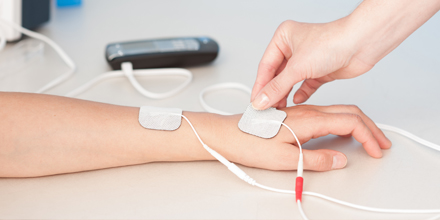Electrotherapy, also known as electrical stimulation or e-stim, is a therapeutic technique that involves the application of electrical currents to the body for various medical and rehabilitative purposes. It is commonly used in physiotherapy, rehabilitation, and pain management. Here are some of the uses and benefits of electrotherapy:
Pain Management: Electrotherapy can help alleviate pain by stimulating the nerves and promoting the release of endorphins, which are natural pain-relieving chemicals produced by the body. It is often used for conditions such as chronic pain, musculoskeletal injuries, and post-surgical pain.
Muscle Rehabilitation: Electrical stimulation can be used to help re-educate or strengthen muscles that have been weakened due to injury, surgery, or neurological conditions. It can help prevent muscle atrophy and improve muscle coordination.
Wound Healing: Some forms of electrotherapy, such as low-level laser therapy and pulsed electromagnetic field therapy, are used to promote tissue healing and wound repair. These therapies can stimulate blood flow, cell growth, and collagen production in the affected area.
Reducing Muscle Spasms: Electrotherapy can help reduce muscle spasms by calming overactive nerve signals. This is particularly useful in conditions such as muscle strains, sprains, and certain neurological disorders.
Improving Circulation: Certain types of electrotherapy, like transcutaneous electrical nerve stimulation (TENS), can enhance blood circulation by causing blood vessels to dilate. Improved circulation can help deliver more oxygen and nutrients to tissues and promote healing.
Nerve Stimulation: Electrotherapy can be used to stimulate nerves and improve their function in cases of nerve damage or neuropathy. It can help restore sensation, reduce tingling or numbness, and enhance nerve regeneration.
Swelling Reduction: Electrical stimulation can help reduce swelling by promoting fluid movement within tissues and enhancing lymphatic drainage.
Enhancing Drug Delivery: Electrotherapy methods like iontophoresis involve using electrical currents to facilitate the penetration of certain medications through the skin. This technique can be helpful for localized pain relief or inflammation reduction.
Neuromuscular Reeducation: After injuries or surgeries, the brain might lose the connection with certain muscles. Electrotherapy can be used to help reestablish the communication between the brain and muscles, aiding in movement and functionality recovery.
It’s important to note that electrotherapy should only be administered by qualified healthcare professionals who understand the techniques, protocols, and safety measures associated with this treatment. The type of electrotherapy used, the intensity of the electrical currents, and the duration of treatment depend on the individual’s condition and needs. If you are considering electrotherapy as a treatment option, consult a healthcare provider to determine whether it is appropriate for your specific situation.
There are several types of electrotherapy machines used in physiotherapy to deliver various forms of electrical stimulation for therapeutic purposes. Here are some common types of electrotherapy machines used in physiotherapy:
- Transcutaneous Electrical Nerve Stimulation (TENS): TENS machines deliver low-frequency electrical currents through electrodes placed on the skin. TENS is commonly used for pain relief by stimulating sensory nerves and promoting the release of endorphins. It can help manage chronic and acute pain conditions.
- Electrical Muscle Stimulation (EMS): EMS machines are used to stimulate muscle contractions using electrical currents. This is particularly useful for muscle strengthening, reeducation, and preventing muscle atrophy. EMS can also help with pain relief and reducing muscle spasms.
- Interferential Current (IFC): IFC machines use two medium-frequency currents that intersect and produce an interference pattern. This type of electrical stimulation is effective for pain relief, edema reduction, and muscle relaxation. It can penetrate deeper into tissues compared to TENS.
- Russian Stimulation: Russian stimulation machines deliver bursts of medium-frequency electrical currents, designed to mimic the firing patterns of healthy muscles. It’s often used for muscle strengthening, particularly in sports rehabilitation.
- High-Frequency Stimulation: High-frequency stimulation machines deliver electrical currents at high frequencies. They are used for pain relief and promoting tissue healing, such as in wound healing or tissue repair after injuries.
- Iontophoresis: Iontophoresis machines are used to deliver certain medications through the skin using a low-level electric current. This method is often used to manage localized pain, inflammation, and musculoskeletal conditions.
- Laser Therapy: While not strictly an electrotherapy machine, low-level laser therapy uses light energy to promote tissue healing and reduce pain and inflammation. It’s often used in conjunction with other physiotherapy treatments.


